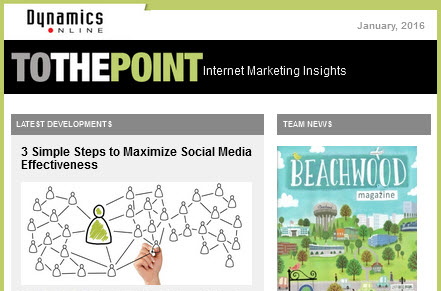Sample Content Marketing Timeline for Small Business – Month One
If you’re a small business or non-profit organization, chances are you’re working with a limited budget. In addition, you have little time to dedicate to activities outside your normal realm of operations, which likely doesn’t include content marketing – even though you wish it could.
If this sounds like your situation, this article is right up your alley.
We’ve outlined below a sample content marketing timeline, broken down by months and by weeks, for you to follow as you begin implementing your content marketing campaign. This is the first in a series of posts that can help you plan out and properly time the execution of your content marketing campaign.
The framework calls for no more than 5-6 hours each week dedicated to implementing your campaign. However, the hours suggestions below are just that: suggestions. They come from a wide range of marketing agency experience here at Dynamics, while taking into account the limited amount of time with which you have to work.
(Note that everything below presumes you have done your preliminary research and know who your target audiences are and what social media platforms they tend to use. You also have an idea regarding the type of content you’ll be posting, be it for local SEO or otherwise. This is a strictly tactical and technical timeline.)
Content Marketing Plan Implementation – Month One
Week One
Keyword Research (3 hours)
We recommend this as the first step because it can play a role in how you establish your blog, helping determine long-term strategy and future blog topics. If you don’t have a name to which you already share an emotional attachment, this part of the process can influence the title of your blog, as well.
This is often an overlooked step in the process of building out a content marketing campaign. Because we’re part of the industry we think we know the buzzwords. Unfortunately, if we haven’t done the keyword research, we don’t.
Blog Setup and Customization (3-5 hours)
Time to establish the beating heart of your content marketing strategy! Set up your blog, install WordPress, choose a theme and customize at will. Be sure to include a sign-up form for people to subscribe to your updates. The level of customization you want to achieve with your blog – whether you want it to be an exact match to your website or have a look all its own – will determine how much time you spend customizing it (hence the range of suggested hours).
Here are a couple examples of blogs we’ve customized to look exactly like (or as close as possible to) the client’s website:
Week Two
Set Up Email Subscriber Service (5 hours)
This is where we’ll set the heartbeat and automate consistency – a heart that doesn’t beat doesn’t do anybody any good. Set up your email subscriber service, whether it’s VerticalResponse, MailChimp, or aWeber. Some of these, like MailChimp, have a free version that can be used for a certain amount of broadcasts per month, while others have tiered approaches based on subscribers. Pick your poison.
Most email marketing services allow you the option to set up auto-responders and broadcast emails (in addition to notifications of new blog posts) around email lists you’ve built up over time. These emails should be customized and branded with imagery and messaging that aligns with your overall content marketing campaign.
Now is also the time to set up confirmation pages for subscribers. After a period of time, this page will have product offerings on it that you can market to new audience members. In the beginning it might be a good idea to link to one of your first pillar articles (see Week Four) to demonstrate the wealth of content you’re distributing.
Week Three
Set Up Social Media Profiles (2-3 hours)
Time to connect that beating heart to the rest of the world. The time spent on setting up social media profiles is dependent on how many platforms you deem appropriate for your business. Here is a quick list of the top social media platforms that you might find useful:
|
|
For whichever platforms you choose, ensure your profiles are completely filled out and optimized with appropriate keywords. We recommend using HootSuite or another third party to post to social platforms like Twitter, LinkedIn and Google+. You don’t want to post to Facebook using any third-party APIs because Facebook will limit the exposure of your posts. They don’t like it when you don’t visit their site and see their ads. “No soup for you!”
Establish Metrics (1 hour)
Know how to check your pulse and ensure you have Google Analytics installed on your blog and your site. Also be sure to familiarize yourself with metrics inherent in your chosen platforms: Facebook Insights, custom reporting on HootSuite, email service provider analytics, etc. This is something you’ll spend more time with down the line, so if you’re really crunched for time, this can take as little as 15 minutes to get set up. Just be sure you have some reporting mechanism in place so you have a benchmark from which to work.
Week Four
WRITE! (4-5 hours)
In addition to a few shorter blog posts, write 1-2 pillar articles that first month – articles that will be valuable to your readers for years to come. Don’t feel too pressured here. If you’re only able to generate some smaller posts, given either the nature of your industry or time restrictions, a little bit of something is better than a whole lot of nothing. However, we don’t recommend you “launch” until you have at least one primary pillar article to which you can refer visitors.
Here is when you can also begin writing the initial array of social media postings. Don’t neglect the copywriting on the social end of the dynamic. A well-written headline and teaser can pull in exponentially more visitors than if you leave this step as an afterthought.
Publish and Connect (2 hours)
This step can also be called “Launch,” but with such a versatile realm like the Internet and the dynamic nature of interactions and continuous content creation, it seems to me that we are always launching: a new blog post, a new eBook, a new video, etc.
This is where, once you’ve published the beginnings of your content, you begin:
- . . . populating social media accounts with an initial range of content
- . . . reaching out to people on Twitter and following them
- . . . increasing the activity on your personal LinkedIn account and notifying your connections regarding your new business page
- . . . using Facebook as the business page and liking and interacting with other Facebook pages that are within the industry
- . . . emailing your list of existing contacts to let them know what you are doing
At this point you can rest on your laurels for about 30 seconds before you have to put your nose back to the grindstone.
Preview of Month Two Activities
Here is a preview of the activities we’ll be discussing for your Month Two content marketing implementation.
- Set Up Advertising on Social Networks
- Establish a PPC Campaign
- Set Up Landing Page(s) to Convert Visitors
- Keep Creating Content
- Begin Planning Long-Term Content
- Begin Positioning for a Product Offering
Read Month Two Content Marketing Activities Now »
Still worried you don’t have the time or the know-how to implement a well-rounded content marketing plan?
Feel free to reach out to us at any time to let us know of your concerns. We’re happy to walk you through this process and assist along the way in whatever capacity you deem fit.
Jeff Hirz is the Social Media and Content Marketing Manager at Dynamics Online.
You can reach him by calling (216) 292-4410.


